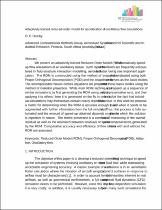 ResearchSpace
ResearchSpace
Adaptively trained reduced-order model for acceleration of oscillatory flow simulations
JavaScript is disabled for your browser. Some features of this site may not work without it.
- ResearchSpace
- →
- Research Publications/Outputs
- →
- Conference Publications
- →
- View Item
| dc.contributor.author |
Oxtoby, Oliver F

|
|
| dc.date.accessioned | 2012-10-22T10:21:52Z | |
| dc.date.available | 2012-10-22T10:21:52Z | |
| dc.date.issued | 2012-07 | |
| dc.identifier.citation | Oxtoby, OF. Adaptively trained reduced-order model for acceleration of oscillatory flow simulations. 10th World Congress on Computational Mechanics (WCCM 2012), Sao Paulo, Brazil, 8-13 July 2012 | en_US |
| dc.identifier.isbn | 9788586686702 | |
| dc.identifier.uri | http://hdl.handle.net/10204/6203 | |
| dc.description | 10th World Congress on Computational Mechanics (WCCM 2012), Sao Paulo, Brazil, 8-13 July 2012 | en_US |
| dc.description.abstract | We present an adaptively trained Reduced-Order Model (ROM) to dramatically speed up flow simulations of an oscillatory nature. Such repetitive flowfields are frequently encountered in fluid-structure interaction modelling, aeroelastic flutter being one important application. The ROM is constructed using the method of snapshots and evaluated using both Proper Orthogonal Decomposition (POD) and the snapshots themselves as the basis modes. The incompressible Navier-Stokes equations are projected onto these basis modes using the method of Galerkin projection. While most ROM techniques try to speed up a sequence of similar simulations by first generating the ROM using selected representative runs, and then applying it to others, here it is generated on the fly in order to exploit the fact that individual simulations may themselves contain nearly-repetitive behaviour. In this work we propose a metric for determining when the ROM is accurate enough to use and when it needs to be augmented with further information from the full simulation. Thus, the process is fully automated and the amount of speed-up obtained depends on the degree to which the solution is repetitive in nature. The metric presented is a combination of monitoring of the overall residual as well as the mismatch between residuals of spatial and temporal terms generated by the ROM. Comparative accuracy and efficiency of flow simulations with and without the ROM are assessed. | en_US |
| dc.language.iso | en | en_US |
| dc.relation.ispartofseries | Workflow;9368 | |
| dc.subject | Reduced Order Model | en_US |
| dc.subject | ROM | en_US |
| dc.subject | Proper Orthogonal Decomposition | en_US |
| dc.subject | POD | en_US |
| dc.subject | Oscillatory flow simulations | en_US |
| dc.title | Adaptively trained reduced-order model for acceleration of oscillatory flow simulations | en_US |
| dc.type | Conference Presentation | en_US |
| dc.identifier.apacitation | Oxtoby, O. F. (2012). Adaptively trained reduced-order model for acceleration of oscillatory flow simulations. http://hdl.handle.net/10204/6203 | en_ZA |
| dc.identifier.chicagocitation | Oxtoby, Oliver F. "Adaptively trained reduced-order model for acceleration of oscillatory flow simulations." (2012): http://hdl.handle.net/10204/6203 | en_ZA |
| dc.identifier.vancouvercitation | Oxtoby OF, Adaptively trained reduced-order model for acceleration of oscillatory flow simulations; 2012. http://hdl.handle.net/10204/6203 . | en_ZA |
| dc.identifier.ris | TY - Conference Presentation AU - Oxtoby, Oliver F AB - We present an adaptively trained Reduced-Order Model (ROM) to dramatically speed up flow simulations of an oscillatory nature. Such repetitive flowfields are frequently encountered in fluid-structure interaction modelling, aeroelastic flutter being one important application. The ROM is constructed using the method of snapshots and evaluated using both Proper Orthogonal Decomposition (POD) and the snapshots themselves as the basis modes. The incompressible Navier-Stokes equations are projected onto these basis modes using the method of Galerkin projection. While most ROM techniques try to speed up a sequence of similar simulations by first generating the ROM using selected representative runs, and then applying it to others, here it is generated on the fly in order to exploit the fact that individual simulations may themselves contain nearly-repetitive behaviour. In this work we propose a metric for determining when the ROM is accurate enough to use and when it needs to be augmented with further information from the full simulation. Thus, the process is fully automated and the amount of speed-up obtained depends on the degree to which the solution is repetitive in nature. The metric presented is a combination of monitoring of the overall residual as well as the mismatch between residuals of spatial and temporal terms generated by the ROM. Comparative accuracy and efficiency of flow simulations with and without the ROM are assessed. DA - 2012-07 DB - ResearchSpace DP - CSIR KW - Reduced Order Model KW - ROM KW - Proper Orthogonal Decomposition KW - POD KW - Oscillatory flow simulations LK - https://researchspace.csir.co.za PY - 2012 SM - 9788586686702 T1 - Adaptively trained reduced-order model for acceleration of oscillatory flow simulations TI - Adaptively trained reduced-order model for acceleration of oscillatory flow simulations UR - http://hdl.handle.net/10204/6203 ER - | en_ZA |





